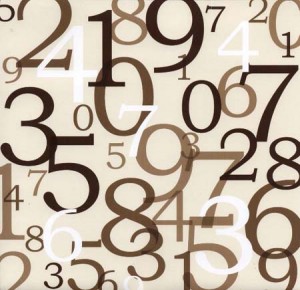In Part 1 I mentioned that John McCarthy, computer and cognitive scientist who coined the term “artificial intelligence” stated…”he who refuses to do arithmetic is doomed to talk nonsense.”
Recently I wrote about KPIs, Key Performance Indicators. In Part 1 of this series, I presented a few ratios that might be your KPIs, or a part of your overall watchfulness of the numbers in your business. In this post I’m going to review some calculations to determine what typically happens in your business. There are four common methods of calculating a typical value: mean, median, mode and midrange. Don’t run – stick with me – it will be painless, I promise, and if you need more help, call for an appointment to work on the numbers for your business.
When I work with a client I often ask them to walk me through the numbers involved in their business. I’m impressed when the business owner has done enough analysis of their numbers to talk about things that are typical – whether they know the names of the following concepts or not.
A Mean (or average) is calculated by adding the quantities of all data points, then dividing by the number of data points. Averages are simple to calculate, but prone to unusual highs and lows – outliers that skew the average too high or low to be representative. (Once the outliners are excluded, the average becomes more accurate.)
For example, what is your average sale for the day? Add up all the sales for the day, then divide by the number of sales you had and you’ll have your average sale. Let’s use sales of $30, $32, $34, $45 and $1000. Adding the sales up and dividing by the number of sales gives an average sale of $228
A Median is calculated by sorting the values in order of high to low, then finding the value of the data point in the middle. The Median is where 50 percent of the values in the set are below and 50 percent are above the value.
In the same list of sales values, $30, $32, $34, $45, $1000, the Median is $34. Half of the numbers in the list are lower, and half are higher. If you needed to make a projection about the value of your next sale, should you use the Median of $34, or the Mean (average) of $228? Sometimes using “average sale” ($228) leads you in the wrong direction until you eliminate the outliers and use the modified average of $35.25 (eliminating the $1000 sale from the list). Comparing your Median with your Mean is a good sanity check to make sure you don’t have some outliers that need to be removed from the calculation.
A Mode is the value that occurs most frequently in a set of data. Modes are useful for finding clusters of data – a set can have multiple modes, which can alert the business owner to interesting interdependencies in the system that produced the data.
A restaurant or other business may see many of the same price tickets – the total cost of the daily special plus taxes. Seeing this pattern in the system can provide good feedback on whether the daily special pricing scheme is working well or if it has little to no influence on what people actually buy.
The Midrange is the value halfway between the highest and lowest data points in a set of values. The Midrange is calculated by adding the highest and the lowest values, then dividing by two. Midranges are quick estimates – but they can be easily be skewed by outliers that are abnormally high or low.
Using the same series of numbers we used before: $30, $32, $34, $45, $1000, the Midrange is $515. In this case not a good number to use for estimating the next sale, but I find that this calculation is what some business owners use.
You don’t need to know the correct names of the calculations above, but you do need to know when to use which one in your business. As you make projections for the future of your business, what numbers should you be watching?
If you need help determining your Key Performance Indicators, call 931-456-4910 and schedule an appointment. We’ll help you with KPIs, ratios, means, medians, modes and midranges and many other business topics.


